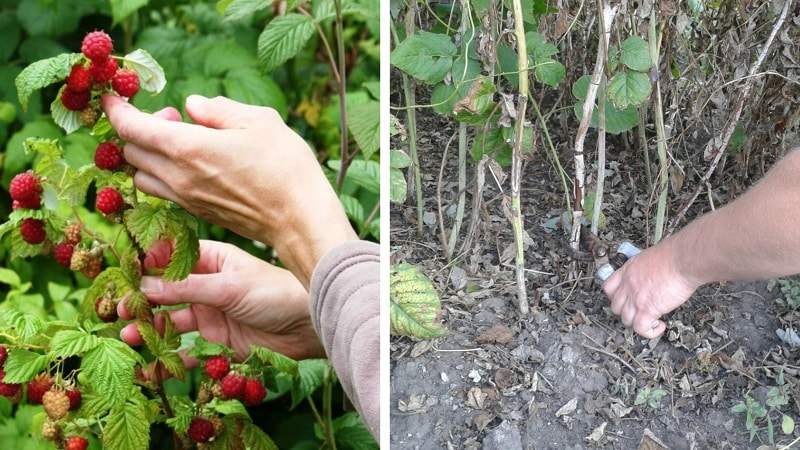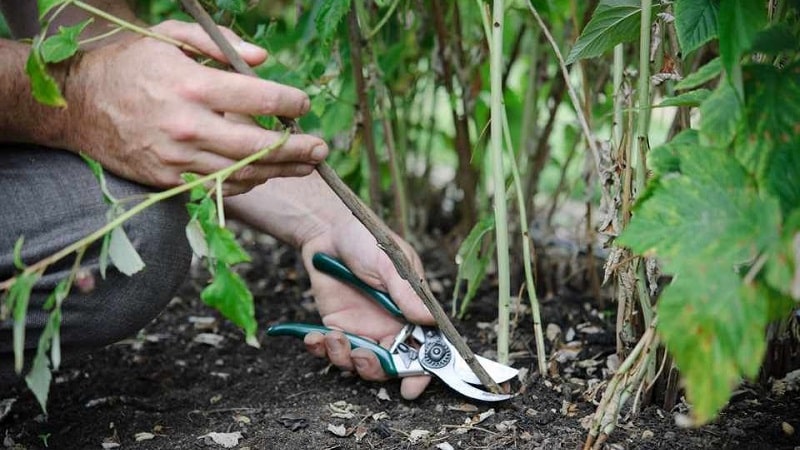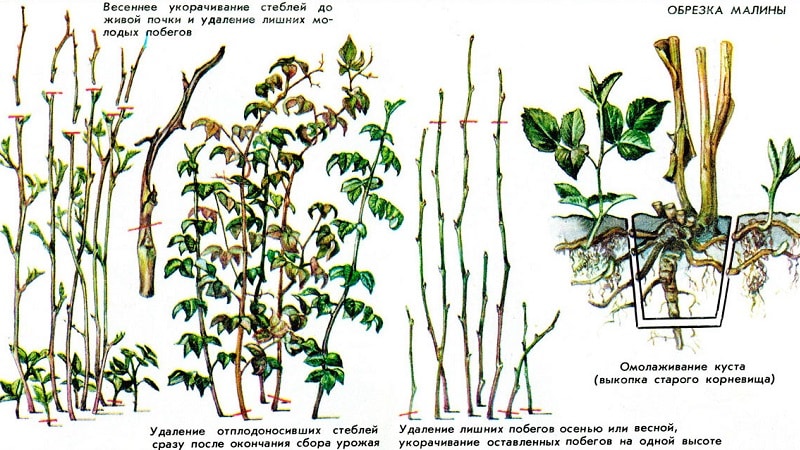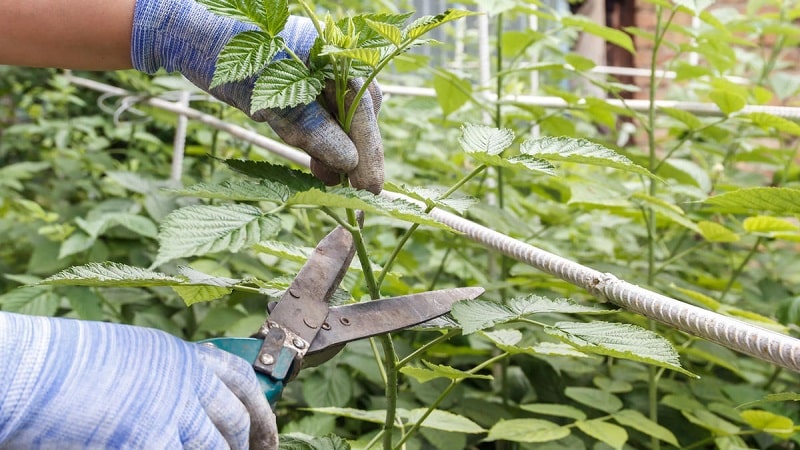How and when to prune raspberries in the summer after fruiting: instructions for beginner gardeners
Proper pruning of raspberries after harvest is the key to health and high productivity in future seasons. The plant adapts better to the dormant period, in the spring it immediately begins to grow, and in the summer it produces many flower stalks and fruits. When to prune raspberries in the summer after fruiting and how to do it correctly, read the article.
Why prune raspberries after fruiting?
Raspberry ripening begins in early July and ends at the end of the month. Over the entire period, approximately 10-12 fruit collections are performed. Large-fruited varieties ripen 2 weeks later. After harvesting the main harvest, when only a few fruits remain on the bushes, gardeners begin to prepare the raspberries for wintering.
Raspberry pruning - an important stage of care, which consists in removing all fruit-bearing branches and maintaining the viability of the bush. Replacement shoots should be preserved on it.

Branches are cut as close to the soil as possible, then removed from the site, burned or buried deeply to prevent the spread of infections.
It is recommended to trim excess young shoots. Their excessive quantity leads to loss of nutrients, shading of young shoots, which grow thin, tall and do not mature completely. There is a decrease in the immunity and resistance of raspberries to insect pests. The best buds, located in the middle part of the shoot, ripen poorly.
After harvest It is recommended to standardize the width of the tape. It is better to plant raspberries using a tape method to increase productivity and ease of caring for bushes. The width of the tape at the base is 40 cm, the distance between the stems remaining after pruning is 10-15 cm. The optimal load per 1 m is 15-20 stems, for large-fruited varieties - 10-12 stems.
After harvest gardeners practice pruning old bushes. The raspberry root system is prone to branching and rises above the ground surface every year. New roots become superficial. This leads to a decrease in the productivity of the bushes and weakening of the branches. At the same time, shoots appear in young areas of the root system, which grow and bear fruit more powerfully.
The lifespan of mother bushes is 6-12 years, so young shoots are left to bear fruit, and old bushes are removed. This type of raspberry maintenance is called strip with mandatory rejuvenation. Old bushes are removed with a sharp shovel and burned, the remaining bushes are watered and fed generously.
Pruning goals
Purposes of summer pruning after harvest:
- thinning bushes for better ventilation and access to sunlight;
- increased productivity;
- prevention of fungal infections and the spread of insects;
- increased winter hardiness;
- giving the bushes an aesthetic appearance.
Timing for pruning raspberries after harvest
Experienced gardeners It is recommended not to delay pruning raspberries after harvesting., citing the fact that fruit-bearing shoots need to be removed as early as possible, and special attention should be paid to diseased and weak shoots. This will allow the bush to enter the period of preparation for winter, and not waste energy on growing shoots. In recent years, there has been an increase in bacteria and fungi, and raspberries are among crops that are highly susceptible to various diseases.
There are no specific dates for pruning the bush, it all depends on the growing region. The procedure can be started at the end of summer if the raspberries have stopped bearing fruit. The exception is remontant varieties that bear fruit again in the fall. Pruning of such raspberries is carried out after leaf fall, since the plant transfers nutrition from the leaves to the roots.
You need to do it 3-4 weeks before the first frost. The approximate dates for pruning in the regions of the middle zone are the second ten days of August - September, in Siberia and the Urals - August, in the south - in July - November.

Favorable days
Favorable days in 2020 according to the lunar calendar:
- July - 1-3, 7-18, 22-31;
- August - 1, 5-10, 12-17, 21-24, 26-31;
- September - 4-9, 11-15, 19-20, 24-30;
- October - 4-9, 11-14, 18-22, 24-29;
- November - 2-13, 17-21, 23-28.
Favorable days in 2021:
- July - 3-8, 13-17, 19-23, 27, 28, 31;
- August - 1-6, 10-15, 17-19, 23, 27-31;
- September - 1-3, 8-13, 15, 16, 19, 20, 24-30;
- October - 3, 4, 7-13, 16-21, 26, 27, 31;
- November - 1-3, 6-11, 13, 14, 17-19, 23, 24, 27-30.
How to prune raspberries correctly
Raspberries, like other fruit and berry bushes, cut according to the rules:
- Two-year-old, dry, weak and fungal-affected shoots that bear fruit are pruned first. Biennial branches have dark brown bark; annual branches have greenish or light brown bark.
- Pruning is done at ground level, leaving stumps a maximum of 5 cm in height to prevent the development of fungal diseases. Pests find refuge in stumps 20-30 cm high.
- For pruning, use sharpened pruning shears. It is first disinfected in medical alcohol, a strong solution of potassium permanganate or 1% copper sulfate.
- Since raspberry bushes are thorny, it is advisable to protect your hands with gloves or use a long-handled lopper when working.
- Bushes affected by gall midges are pruned below the thickening (nest with larvae), leaving a stump of 50-60 cm.
- Stems with brown or black spots (purple spot) are cut back at soil level. If the entire plant is affected, it is uprooted.
- On each bush, 5-6 strong and strong annual shoots are left, or up to 10 pcs. by 1 m with tape planting.
- After the end of fruiting, the tops of the branches of ordinary raspberries are shortened by 20-30 cm.
- The cut shoots are taken to the perimeter of the site and burned.
- The double pruning method is used only for regular raspberries. In remontant varieties, annual growths are not removed, since the crop is laid at the ends of the shoots.
- Tall but unbranched annual stems are cut off completely, as they will not produce a harvest.
- The first double pruning is carried out in early June, when the shoots reach 70-90 cm, and the tops are cut by 10-15 cm. The second double pruning is carried out in early autumn - the tops are cut by 5-15 cm. As a result, the shoots branch out and produce more yield.

The nuances of pruning remontant raspberries
Remontant raspberry differs from the usual ability to bear fruit on one-year and two-year-old shoots. With proper care, the second wave of fruiting occurs in the fall.
The desire to get the maximum yield plays a cruel joke on many gardeners. Partial pruning of shoots leads to weakening of the plant, infection with fungal infections and loss of varietal qualities. In the case of remontant raspberries, it is necessary to remove the entire above-ground part, leaving no stumps.
To get 2 harvests per season, it is recommended to leave 5-6 of the strongest shoots on each bush, shorten them by 1/3 and cover them for the winter, bending them down for the winter. In the spring, frozen or diseased shoots are removed, the rest are left, small shoots are cleared to prevent thickening.
Post-procedure care
After harvesting, the raspberry plant needs special care and preparation for winter.
Watering
Raspberries love moisture, but in moderation. When there is an excess of it, the root system begins to rot. After harvesting, the raspberries are generously shed with water to a depth of 40-50 cm. This type of watering is called moisture-recharging. It helps the plant to survive the winter. In the spring-summer period, the bushes are watered 5-6 times.
In August–September, watering is stoppedso that the plant completes growth and prepares for winter. In arid areas, winter watering is carried out in October - 50-100 liters per 1 m².
Top dressing
After harvesting, especially in the 2-3rd year of fruiting, raspberries need feeding potassium, phosphorus and nitrogen. It is important to maintain a balance of minerals - both excess and deficiency are dangerous.
Reference. When there is an excess of nitrogen, the raspberry bark cracks and is damaged by gall midges and purple spot. As a result, resistance to frost decreases.
Phosphorus-potassium compounds are applied in late summer - early autumn. Gardeners prefer to use potassium without chlorine: 30-60 g of potassium sulfate, 20-30 phosphate rock per 1 m². Wood ash is especially popular due to its balanced content of potassium and phosphorus - 100 g per 1 m².
After fertilizing, the soil is mulched with compost or peat. layer of 2-3 cm. Organic matter is added every year - 2-3 kg per 1 m² - or every other year - 4-6 kg per 1 m². On depleted soils, raspberries are fed with organic matter annually - 10-15 kg per 1 m². It is recommended to use rotted manure or compost.Organic matter is scattered between rows in a layer of 5-15 cm.
Raspberries respond gratefully to microfertilizers with magnesium and boron. With magnesium deficiency, the leaves turn yellow from the center to the edges and fall off prematurely. If there is a lack of boron in the spring, buds and side branches do not form. In the fall, the bushes are fertilized with magnesium sulfate - 25-35 g per 1 m², and in the spring they add borax - 1.5-2 g m².
After harvesting, it is recommended to check the acidity of the soil. Raspberries grow best on soil of medium mechanical composition and humus. On light, low-humus soils, deoxidation is performed with dolomite flour 40-50 g per 1 m², on neutral and excessively acidic soils - 600 g per 1 m². Dolomite flour also serves as a source of magnesium.
The soil in the tree trunk is loosened, weeds and plant debris are removed. They work with a hoe within a radius of 1 m from the center of the bush, at a depth of 5-7 cm, so as not to damage the roots, which are located below 8-10 cm.
Preparing for winter
After pruning raspberries at the end of the fruiting season, gardeners start preparing for winter. If there are leaves left on the shoots, they are carefully removed, leaving the buds. The branches are then tied in bunches using metal staples and bent to the ground.

The most dangerous zone is located at a height of 50 m from the ground surface, this is where shoots are often damaged by frost. In most Russian regions in January, the thickness of the snow cover does not exceed 40 cm. The shoots are uncovered in the zone of concentration of frosty air. Therefore, for reliability, the bundles are covered or wrapped with non-woven material - agrofibre or tarpaulin.
To protect against rodents, bushes are covered with barbed wire, netting, and spruce branches., lay out poisonous baits.Gardeners in the northern regions are advised to bend the branches as close to the ground as possible and cover them with straw. In windy areas, snow protection is constructed from plywood or polycarbonate on the leeward side.
Reference. The branches are bent at an air temperature of +10°C, since they break in the cold.
Prevention of pests and diseases
The main pest of raspberries is the shoot gall midge, or raspberry mosquito.. To completely get rid of the pest, it is recommended to dig the plantation deeply and incorporate mineral fertilizers into the soil. Pesticides must not be used after harvesting.
Preventative treatment against fungal infections is carried out using Bordeaux mixture mixed with laundry soap for better stickiness.
Free soil between rows is dug up deeplyto destroy pest nests. This is effective against the flower beetle (raspberry-strawberry weevil), stem fly, shoot gall midge, and spider mite.
Plant residues are carefully collected, taken outside the plantation and burned. They hide the larvae of weevils, raspberry stem and shoot gall midges, pathogens of septoria, purple spot, rust, and anthracnose. Mulching with a thick layer helps protect bushes from insects and fungal infections.
Advice from experienced gardeners
Advice from experienced gardeners will help preserve raspberry bushes after harvest:
- Cut out all fruit-bearing branches after harvest.
- Practice pruning in dry weather. The shoots will warm up and dry out, making it easier to prune.
- Place the pruning shears at ground level or slightly deeper, do not leave stumps that serve as a haven for fungi, bacteria and insects.
- Beginning gardeners often trim the edges of the bushes and leave the center untouched. On the one hand, such a haircut increases productivity, but on the other hand, it weakens the plant. Leave 5-7 branches on the bush around the entire circumference and be sure to thin out the middle. This will ensure excellent aeration and pollination of the bush next season.
- Don't forget to disinfect your tools before use to prevent fungal infection.
- Fan the branches remaining after pruning so that they do not overlap each other.
- First prune thick two-year-old branches, then trim young growth.
- Pluck shoots that ripen in July by hand at the base; they still won’t have time to ripen before the cold weather arrives.
- Trim the repairing raspberries after the second wave of fruiting. As soon as the plant loses its leaves, shorten two-year-old bushes to the root, and trim the tops of annual bushes by 15-20 cm.
Conclusion
Raspberry tree care does not end with harvesting. The gardener's work is in full swing until the cold weather sets in. Immediately after harvesting the fruits, begin pruning the bushes. The timing depends on the growing region and lasts from August to November.
In ordinary raspberries, two-year-old fruit-bearing shoots are cut at the root, leaving 5-7 branches on the bush. Remontant varieties are pruned after the second wave of fruiting, shortening two-year-old branches at the root; the tops of annual ones are cut off by 15-20 cm. Subsequent care consists of water-replenishing watering, applying mineral and organic fertilizers, mulching the soil, and covering the bushes for the winter.